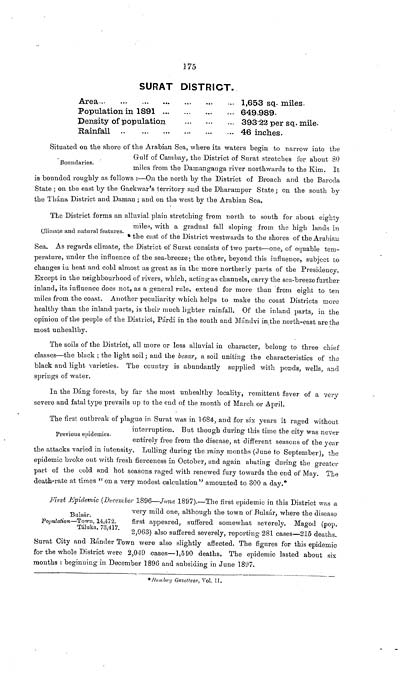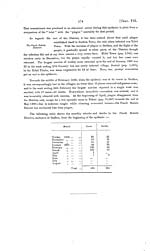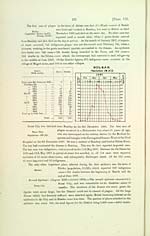Medicine - Disease > Bombay plague: being a history of the progress of plague in the Bombay presidency from September 1896 to June 1899
(243) Page 175
Download files
Individual page:
Thumbnail gallery: Grid view | List view

175
SURAT DISTRICT.
Area... ... ... ... ... ... ... 1,653 sq. miles
Population in 1891 ... ... ... ... 649,989.
Density of population ... 393.22 per sq. mile.
Rainfall .. ... ... ... ... ... 46 inches.
Boundaries.
Situated on the shore of the Arabian Sea, where its waters begin to narrow into the
Gulf of Cambay, the District of Surat stretches for about 80
miles from the Damanganga river northwards to the Kim. It
is bounded roughly as follows :-On the north by the District of Broach and the Baroda
State ; on the east by the Gaekwar's territory and the Dharampor State ; on the south by
the Thna District and Daman ; and on the west by the Arabian Sea.
Climate and natural features.
The District forms an alluvial plain stretching from north to south for about eighty
miles, with a gradual fall sloping from the high lands in
the east of the District westwards to the shores of the Arabian
Sea. As regards climate, the District of Surat consists of two parts-one, of equable tem-
perature, under the influence of the sea-breeze ; the other, beyond this influence, subject to
changes in heat and cold almost as great as in the more northerly parts of the Presidency.
Except in the neighbourhood of rivers, which, acting as channels, carry the sea-breeze further
inland, its influence does not, as a general rule, extend for more than from eight to ten
miles from the coast. Another peculiarity which helps to make the coast Districts more
healthy than the inland parts, is their much lighter rainfall. Of the inland parts, in the
opinion of the people of the District, Prd in the south and Mndvi in the north-east are the
most unhealthy.
The soils of the District, all more or less alluvial in character, belong to three chief
classes-the black ; the light soil ; and the besar, a soil uniting the characteristics of the
black and light varieties. The country is abundantly supplied with ponds, wells, and
springs of water.
In the Dang forests, by far the most unhealthy locality, remittent fever of a very
severe and fatal type prevails up to the end of the month of March or April.
Previous epidemics.
The first outbreak of plague in Surat was in 1684, and for six years it raged without
interruption. But though during this time the city was never
entirely free from the disease, at different seasons of the year
the attacks varied in intensity. Lulling during the rainy months (June to September), the
epidemic broke out with fresh fierceness in October, and again abating during the greater
part of the cold and hot seasons raged with renewed fury towards the end of May. The
death-rate at times " on a very modest calculation" amounted to 300 a day.*
Bulsr.
Population-Town, 14,472.
Tluka, 73,417.
First Epidemic (December 1896-June 1897).-The first epidemic in this District was a
very mild one, although the town of Bulsr, where the disease
first appeared, suffered somewhat severely. Magod (pop.
2,063) also suffered severely, reporting 281 cases-215 deaths.
Surat City and Rander Town were also slightly affected. The figures for this epidemic
for the whole District were 2,049 cases-1,590 deaths. The epidemic lasted about six
mouths : beginning in December 1896 and subsiding in June 1897.
* Bombay Gazetteer, Vol. II.
SURAT DISTRICT.
Area... ... ... ... ... ... ... 1,653 sq. miles
Population in 1891 ... ... ... ... 649,989.
Density of population ... 393.22 per sq. mile.
Rainfall .. ... ... ... ... ... 46 inches.
Boundaries.
Situated on the shore of the Arabian Sea, where its waters begin to narrow into the
Gulf of Cambay, the District of Surat stretches for about 80
miles from the Damanganga river northwards to the Kim. It
is bounded roughly as follows :-On the north by the District of Broach and the Baroda
State ; on the east by the Gaekwar's territory and the Dharampor State ; on the south by
the Thna District and Daman ; and on the west by the Arabian Sea.
Climate and natural features.
The District forms an alluvial plain stretching from north to south for about eighty
miles, with a gradual fall sloping from the high lands in
the east of the District westwards to the shores of the Arabian
Sea. As regards climate, the District of Surat consists of two parts-one, of equable tem-
perature, under the influence of the sea-breeze ; the other, beyond this influence, subject to
changes in heat and cold almost as great as in the more northerly parts of the Presidency.
Except in the neighbourhood of rivers, which, acting as channels, carry the sea-breeze further
inland, its influence does not, as a general rule, extend for more than from eight to ten
miles from the coast. Another peculiarity which helps to make the coast Districts more
healthy than the inland parts, is their much lighter rainfall. Of the inland parts, in the
opinion of the people of the District, Prd in the south and Mndvi in the north-east are the
most unhealthy.
The soils of the District, all more or less alluvial in character, belong to three chief
classes-the black ; the light soil ; and the besar, a soil uniting the characteristics of the
black and light varieties. The country is abundantly supplied with ponds, wells, and
springs of water.
In the Dang forests, by far the most unhealthy locality, remittent fever of a very
severe and fatal type prevails up to the end of the month of March or April.
Previous epidemics.
The first outbreak of plague in Surat was in 1684, and for six years it raged without
interruption. But though during this time the city was never
entirely free from the disease, at different seasons of the year
the attacks varied in intensity. Lulling during the rainy months (June to September), the
epidemic broke out with fresh fierceness in October, and again abating during the greater
part of the cold and hot seasons raged with renewed fury towards the end of May. The
death-rate at times " on a very modest calculation" amounted to 300 a day.*
Bulsr.
Population-Town, 14,472.
Tluka, 73,417.
First Epidemic (December 1896-June 1897).-The first epidemic in this District was a
very mild one, although the town of Bulsr, where the disease
first appeared, suffered somewhat severely. Magod (pop.
2,063) also suffered severely, reporting 281 cases-215 deaths.
Surat City and Rander Town were also slightly affected. The figures for this epidemic
for the whole District were 2,049 cases-1,590 deaths. The epidemic lasted about six
mouths : beginning in December 1896 and subsiding in June 1897.
* Bombay Gazetteer, Vol. II.
Set display mode to: Large image | Zoom image | Transcription
Images and transcriptions on this page, including medium image downloads, may be used under the Creative Commons Attribution 4.0 International Licence unless otherwise stated. ![]()
| India Papers > Medicine - Disease > Bombay plague: being a history of the progress of plague in the Bombay presidency from September 1896 to June 1899 > (243) Page 175 |
|---|
| Permanent URL | https://digital.nls.uk/74586454 |
|---|---|
| Description | Chap. VII. Surat District. |




